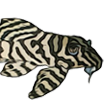Due to high levels of diatoms in a fairly new tank (2 months) I am considering the short- to medium-term addition of otocinclus affinis....having researched the prefered water values of this fish it doesn't seem to be a great idea, especially when they seem to have a reputation for dying on you shortly after introduction.
My water parameters are temp 26.5oC, pH 8.2, GH 17 KH 15 (hard)
I have syno petricola in the tank but they don't eat diatoms at all - are there other options for diatoms feeders or am I reduced to scrubbing? Obviously, I am prepared to forego the Tang authenticity on this issue!!





